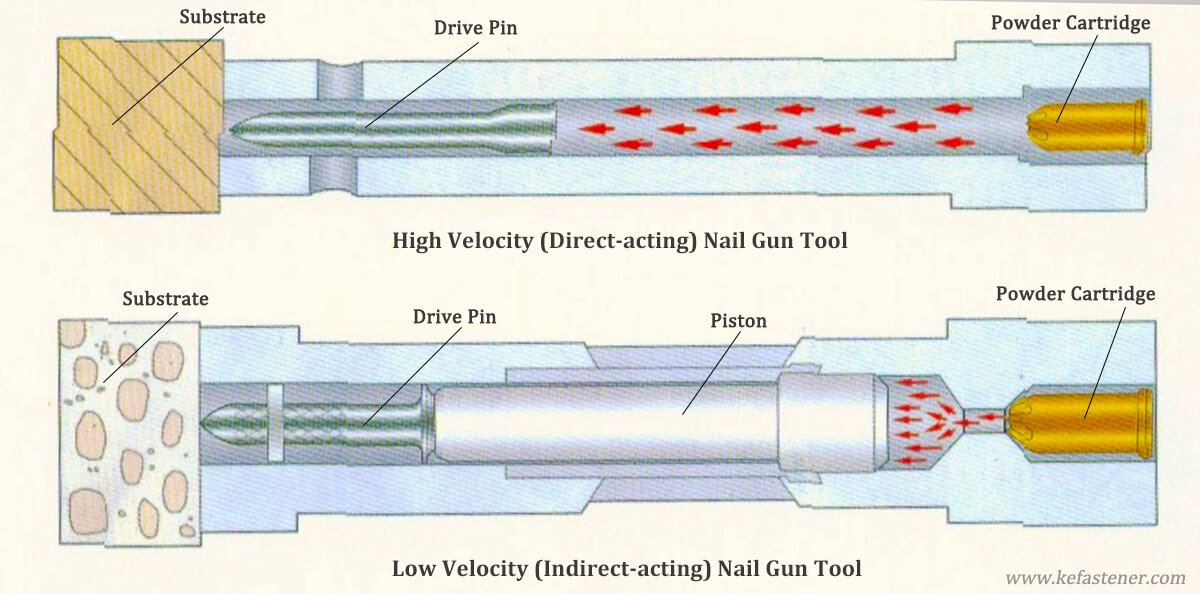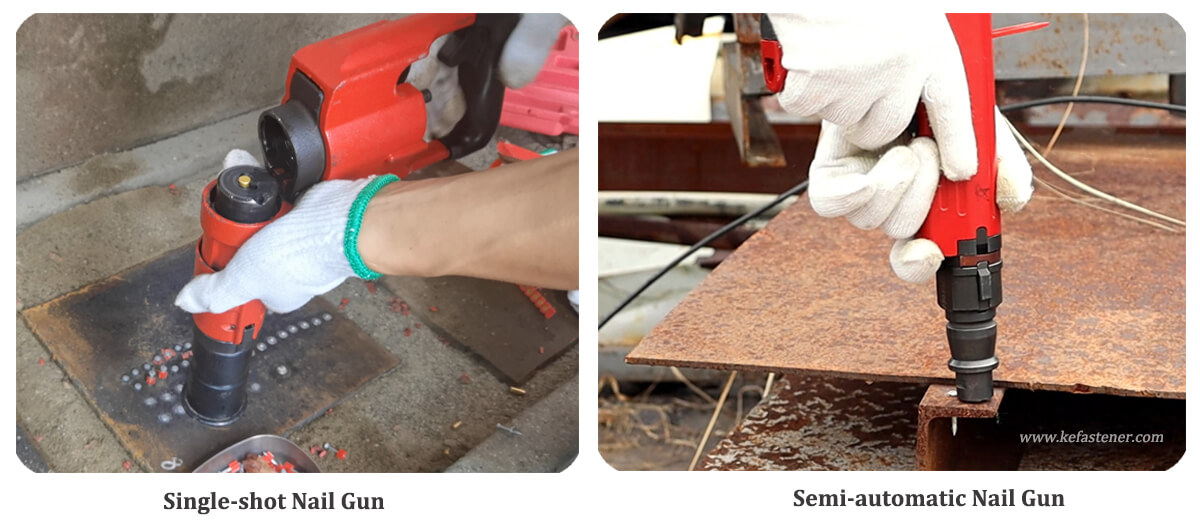Low velocity fastening system belongs to direct fastening. It’s a type of powder actuated fastening technology. This system usually includes the tools (nail guns), powder cartridges and drive pins (nails). The explosion of a nail gun cartridge generates expanding gas. The resulting thrust drives the nails into the substrates, such as concrete or steel plate. So we usually use it for building construction and home decoration.
The low velocity powder actuated tools rely on the inertia of the piston. Once the fastener leaves the piston, its own inertia is insufficient to sustain free flight. Therefore, this low velocity gun has a firing rate. The average velocity of the drive pins is less than 100 meters per second. But it’s also strong enough to secure objects to concrete walls.
Low velocity vs high velocity powder actuated tools:
According to the working principle, powder actuated nail guns have two types. One is a direct-acting nail gun, and the other is an indirect-acting nail gun. For direct-acting fastening system, the gunpowder gas acts directly on the drive pins. High-pressure gas drives the nail to move. Therefore, the nail has a very high speed and kinetic energy when it flies away from the gun. So direct-acting nail gun is also called the high velocity tool.
But the indirect-acting fastening system is different. Inside its barrel, there is a piston component. The propellant gas does not act on the drive pins, but rather on the piston. Energy is transferred to the nails via the piston. Therefore, the nail travels at a lower speed when it leaves the nail gun. So we also call the indirect-acting tool a low velocity gun.
From the above diagram, we can see the principle differences between the two velocity fastening systems clearly. Why is there such a big difference in the firing speed of the two types of nail guns?
Assume the mass of the drive pin is m. The speed of the drive pin in the high-velocity powder actuated nail gun is Vh. And the speed of the drive pin in the low velocity fastening system is Vl. The mass of the piston rod is M. Then the kinetic energies of these two nail guns are respectively given by the following formulas:
Wh = 1/2m(Vh)^2
Wl = 1/2(m + M)(Vl)^2
Under the same conditions, the fastening operation is performed. We can assume that Wh = Wl.
That is, 1/2m(Vh)^2 = 1/2(m + M)(Vl)^2.
Therefore, the mass M of the piston rod is 5 to 15 times the mass m of the drive pin. Let M = 10m. Then 1/2m(Vh)^2 = 1/2(m + 10m)(Vl)^2.
So, Vh/Vl = 3.32.
In summary, we can see that the speed of a high velocity nail gun is more than three times that of a low velocity nail gun. For the low velocity fastening system, the energy generated by firing the powder cartridge includes into two parts: the energy of the drive pin and the energy of the piston. The piston rod accounts for the majority of the energy.
Since the piston rod can only move within the nail barrel, its direction can be controlled by the operator. When the drive pin contacts the substrate, it encounters resistance and its speed decreases. Then piston rod will transfer energy to the drive pin, thus completing the fastening operation.
Besides the differences in structure and principle, their effects of use are also different. The high velocity powder actuated tools have obvious weaknesses. Its fastening reliability can sometimes be poor. Moreover, it may easily damage the substrate structure. Therefore, it is generally not used except in special circumstances. For example, we can use the high velocity gun for repairing steel molds in the metallurgical industry. However, the reliability and safety of low velocity powder actuated tools are far superior to the former. It will not cause “nails skipping”. The fastening effect is just right. So low velocity guns are widely used in decoration construction.
Working principle of low velocity fastening system:
Let’s take the 301 powder actuated nail gun as an example. First, load the drive pin into the nail barrel. Then, insert the powder cartridge strip into the magazine slot at the bottom of the handle. Next, hold the nail gun perpendicular to the work surface and compress it into place. Afterwards, pull the trigger. At this time, the powder cartridge fires and drives the pin into the substrate. Then we release the low velocity tool. So it finishes one fastening operation. How exactly does the low velocity fastening system work?
(1) Gunpowder explosion
We compress the powder actuated tool. The firing pin will generate sufficient pressure at the top of the nail gun. Internal action and reaction forces trigger the projectile into the firing barrel. The gunpowder explodes instantly.
At this time, the firing pin strikes the primer at the base of the powder cartridge. It will ignite the smokeless powder. The combustion of the gunpowder produces high-temperature, high-pressure gas. These gas expands rapidly within the confined space. Thus it creates a powerful thrust source.
This process is the initial stage of energy release. It provides the power basis for the subsequent firing of the drive pins.
(2) Energy conversion and nail firing
High-pressure gas acts directly on the piston rod. Piston acts as the force transmission medium. It evenly distributes the gas’s expansion force to the tail of the drive pin. This generates a tremendous thrust. Under this thrust, the drive pin penetrates concrete and other substrates at extremely high speed.
This process achieves energy conversion. First, the chemical energy of the gunpowder is converted into the gas’s expansion energy. Then, it is converted into the kinetic energy of the nails.
(3) Security and Triggering Mechanism
The low velocity fastening system is designed with multiple safety mechanisms. This ensures safe operation.
First, the nail gun will not fire if the muzzle is not firmly pressed against the substrate. That is, the internal pressure can only reach the trigger threshold when the muzzle is tightly pressed against the substrate.
Second, the low velocity gun will not fire if the trigger is not fully pulled. The trigger must be pulled to a specific position to release the mechanical lock.
Third, it will automatically lock if the angle is off. When the gun body tilts beyond the safe angle, the internal mechanism will block the gunpowder ignition path.
Therefore, these design features ensure the safety of the powder actuated tools.
Types and models of low velocity power shooting guns:
In fact, low velocity hand tools mainly include three types: single-shot, semi-automatic continuous-fire, and fully automatic continuous-fire. They are trigger-actuated nail gun. Additionally, some manufacturers also produce hammer-actuated nail gun. It requires striking with a hammer or similar tool to fire.
(1) Single-shot powder actuated tool
This type of nail gun does not have a magazine slot. Take JD307 single shot tool as an example. When using it, you need to pull out the fastener guide barrel. And then insert the drive pin and powder cartridge separately. Finally, put back the fastener guide. After firing, repeat the previous action to begin the next fastening operation. Below models belong to single-shot powder gun, such as JD307, JD307M, JD450, MC52, JD603, etc.
(2) Semi-automatic fastening tool
This low velocity fastening system is different from the first type. There is a magazine slot in the handle. To use, first insert the drive pin. Then insert the powder loads strip into the magazine slot. Press down and pull the trigger to fire. After firing, drag the nail guide barrel to reload the drive pin. It doesn’t require further reloading of powder loads. Below are some common models, such as JD301 and JD301T.
(3) Fully automatic nail gun
Some companies also have the fully automatic powder actuated tools. When use, it does not require loading drive pins and powder cartridges every time. So it greatly saves working time.
Safe operating procedures of low velocity gun:
1. Operators must have received relevant training. Please read the instruction manual carefully before use.
2. It is strictly forbidden to modify the powder nail gun for other purposes.
3. Users must wear protective glasses. And it should provide protective shields and hearing protection devices when necessary.
4. Children or others must not handle the powder actuated tools.
5. When not in use or when cleaning or disassembling the nail gun, there should be no powder cartridges inside.
6. Do not point the low velocity gun at yourself or others.
7. Never compress the gun barrel with your hands.
8. Do not use the nailer in the presence of flammable or explosive gases or materials.
9. If the nailer does not fire during firing, wait 3 seconds before releasing the nail gun.
10. The low velocity fastening system is not suitable for fragile materials such as tiles, glass, and marble.
11. The powder actuated tools require proper maintenance and upkeep.
Post time: Nov-11-2025











